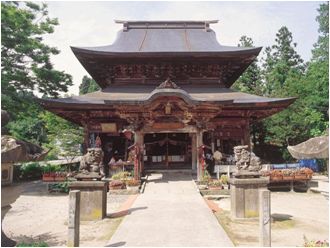
This temple was founded by Morikatsu Tomizuka in 1279.
The eleven-faced Kannon statue enshrined here is said to watch over the land in all directions. It is flanked on the left and right by an unusual pair of statues including Acala, who rids the world of evil (as deity of destruction and regeneration), and the Jizo Bosatsu, responsible for the nurturing earth and all living things.
Morikatsu Tomizuka built the kannon hall for the daughter of Tsunetoshi Egawa, whom he fell in love with but who tragically died, While attempting to move the Kannon statue, his cart became stuck, and so he built the Kannon-do hall on this spot, housing the statue within.
日本遺産 平成28年度認定

Zushi (Altar, Benten-do hall) in Koanji temple old Kannon-Do
- National Designated Important Cultural Property
- Designated on June 9, 1960
This structure originally was a Zushi which enshrine Eleven-faced Kannon Bosatsu stature. When Kannon-do hall has been repaired from 1642 to 1646, the Zushi was carried outside of the hall and changed its name to Benten-do.
The Benten-do was repainted in 1842, and in 1933 the foundation was built and the roof was changed from thatch to tile. Transferring and rebuilding the Benten-do hall from October 1, 1972 to June 30, 1973, it was reconstructed in current storage warehouse.
Aizumisato Town Board of Education

Bronze Eleven-faced Kannon and Two Attendants (Fudo Myo-o and Jizo Bosatsu)
- National Important Cultural Property
Egawa Tsunetoshi, a rich man, cast the statue of the Eleven-faced Kannon for the purpose of praying to Buddha for the happiness of his deceased daughter and dedicated it in Nakata village here, which is dwelled the soul of his dear daughter in 1274. It has been enshrined in Koanji temple Kannon-do hall.
- [Eleven-faced Kannon] It is casting and is 1.87 meters tall / Inscription “August 1274” is on the halo of the Kannon
- [Fudo Myo-o (Acalanatha)-stature] 95.1 centimeters tall
- [Jizo Bosatsu (Ksitigarbha)- stature] 93.9 centimeters tall
All of them are designated national treasure in April 3, 1928 and are re-designated national important cultural property in August 1950
Aizumisato Town Board of Education
